 "ttyymmnn" (ttyymmnn)
"ttyymmnn" (ttyymmnn)
07/19/2016 at 12:35 • Filed to: planelopnik, planelopnik history
 9
9
 28
28
 "ttyymmnn" (ttyymmnn)
"ttyymmnn" (ttyymmnn)
07/19/2016 at 12:35 • Filed to: planelopnik, planelopnik history |  9 9
|  28 28 |
Welcome to This Date in Aviation History , getting of you caught up on milestones, important historical events and people in aviation from July 16 - July 19.
!!! UNKNOWN CONTENT TYPE !!!
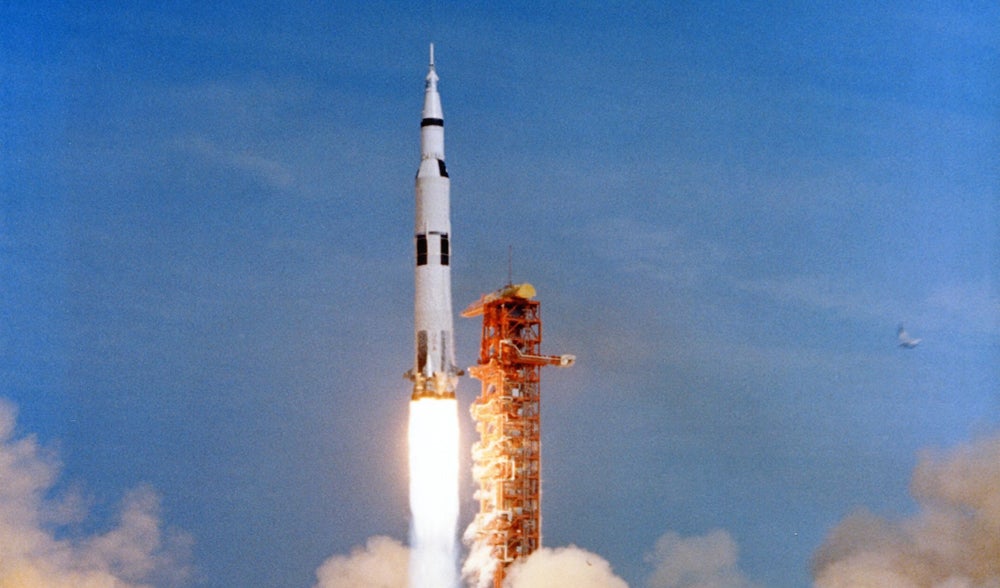
July 16, 1969 – The launch of Apollo 11. By the early 1960s, the !!!error: Indecipherable SUB-paragraph formatting!!! between the Soviet Union and the West had become the dominant political and social struggle in the world, and US President !!!error: Indecipherable SUB-paragraph formatting!!! characterized it in a famous !!!error: Indecipherable SUB-paragraph formatting!!! to a joint session of Congress on May 25, 1961 as a “battle...around the world between freedom and tyranny.” While some of those battles were real shooting wars, the !!!error: Indecipherable SUB-paragraph formatting!!! came to be a potent symbol of that struggle and, by 1961, the Russians were far ahead. They had been the first to put a satellite, !!!error: Indecipherable SUB-paragraph formatting!!! , into earth orbit in 1957, and were the first to put a man, cosmonaut !!!error: Indecipherable SUB-paragraph formatting!!! , into Earth orbit on April 12, 1961. President Kennedy’s speech six weeks after that historic flight galvanized the nation into action, and set the goal of being the first nation to put a man on the Moon. Though Kennedy and NASA trumpeted the scientific gains from such an achievement, he made it clear in a !!!error: Indecipherable SUB-paragraph formatting!!! on September 12, 1962 at Rice University in Houston that beating the Russians to the Moon was as much a matter of national security as it was a matter of scientific discovery.
We set sail on this new sea because there is new knowledge to be gained, and new rights to be won, and they must be won and used for the progress of all people. For space science, like nuclear science and all technology, has no conscience of its own. Whether it will become a force for good or ill depends on man, and only if the United States occupies a position of pre-eminence can we help decide whether this new ocean will be a sea of peace or a new terrifying theater of war.
Following President Kennedy’s declaration of America’s intent to go to the Moon, NASA began working on the technological means to get us there. !!!error: Indecipherable SUB-paragraph formatting!!! , which was currently underway and carried a single astronaut to space, was followed by !!!error: Indecipherable SUB-paragraph formatting!!! , which carried two astronauts into space and put the US ahead of the Russians for good in the race to the Moon. The !!!error: Indecipherable SUB-paragraph formatting!!! would be the most ambitious yet, and it made its first flight of an unmanned rocket in 1966. Development and testing progressed, and the first manned flight was to have been !!!error: Indecipherable SUB-paragraph formatting!!! , but a fire in the Command Module during testing on February 21, 1967 killed the three astronauts onboard. The first manned flight, !!!error: Indecipherable SUB-paragraph formatting!!! , would take place the following year. Apollo 11 was the fifth manned mission of the program, with the four previous missions used to test systems for the voyage and landing, with !!!error: Indecipherable SUB-paragraph formatting!!! coming within 50,000 feet of the lunar surface. Apollo 11 launched atop the mighty three-stage !!!error: Indecipherable SUB-paragraph formatting!!! rocket, which carried the !!!error: Indecipherable SUB-paragraph formatting!!! and !!!error: Indecipherable SUB-paragraph formatting!!! into orbit around the Moon. Astronauts !!!error: Indecipherable SUB-paragraph formatting!!! and !!!error: Indecipherable SUB-paragraph formatting!!! and !!!error: Indecipherable SUB-paragraph formatting!!! arrived at the Moon on July 19, and completed 30 orbits before Armstrong and Aldrin descended to the Moon’s surface on July 20. Collins remained in orbit in the Command Module. The Lunar Module, piloted by Armstrong, touched down on the Moon at 20:17:40 !!!error: Indecipherable SUB-paragraph formatting!!! on Sunday, July 20, and Aldrin radioed to Earth, “Houston, Tranquility Base here. The Eagle has landed.” After making preparations for leaving the Lander, Armstrong descended the ladder on July 21 to become the first human to set foot on the Moon, where he spoke the now-famous words, “That’s one small step for [a] man, one giant leap for mankind.” Armstrong and Aldrin spent about 2-and-a-half hours exploring the area around the Lander and collecting about 48 pounds of rocks and other lunar material. They also planted an American flag on the Moon as a symbol of American achievement, the first of an eventual six that would be placed by subsequent Apollo missions. But that flag, and the five flags planted on subsequent missions, also carried tacit sense of ownership and victory in the race to the Moon. The Russians eventually abandoned their attempts to reach the Moon, focusing instead on their efforts to maintain a manned presence in Earth orbit.
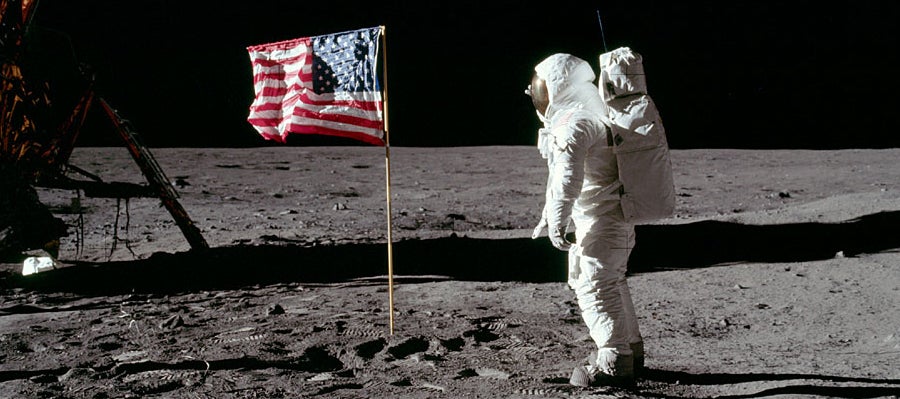
Buzz Aldrin salutes the American flag on the Moon
After roughly 22 hours on the Moon’s surface, Armstrong and Aldrin returned to the Command Module and the three astronauts returned to Earth, splashing down in the Pacific Ocean on July 24. There would be six more Apollo missions to the Moon, including the ill-fated Apollo 13 mission which did not land on the Moon yet safely returned the astronauts to Earth. The final flight of the Apollo program was
!!!error: Indecipherable SUB-paragraph formatting!!!
in 1972. After Apollo 17, the remaining Apollo hardware was used for the
!!!error: Indecipherable SUB-paragraph formatting!!!
and
!!!error: Indecipherable SUB-paragraph formatting!!!
projects.
(NASA photos)
!!! UNKNOWN CONTENT TYPE !!!

July 17, 1989 – The first flight of the Northrop Grumman B-2 Spirit. Though the B-2 looks like something from the pages of science fiction, the flying wing is nothing new. Jack Northrop began experimenting with long-range flying wing bombers in the years after WWII, first with the !!!error: Indecipherable SUB-paragraph formatting!!! and then with the jet-powered !!!error: Indecipherable SUB-paragraph formatting!!! . Though the concept never caught on—or was killed for political reasons—it was not forgotten. In 1979, the US Air Force initiated the !!!error: Indecipherable SUB-paragraph formatting!!! (ATB) program to find a replacement for the venerable !!!error: Indecipherable SUB-paragraph formatting!!! and to take advantages of advances in !!!error: Indecipherable SUB-paragraph formatting!!! , which, while not making an aircraft invisible to radar, would make aircraft practically undistinguishable from other radar clutter. Lockheed was the first to take advantage of stealth, proving the concepts and putting it into practice with the super-secret !!!error: Indecipherable SUB-paragraph formatting!!! program. They followed that with the successful development of the !!!error: Indecipherable SUB-paragraph formatting!!! , which first flew in 1981. Stealth had finally become a reality, and it would become an important element of any new bomber under consideration. As the ATB program progressed, the Air Force took proposals from defense contractors for a new bomber and narrowed their selection down to proposals from Northrop/Boeing, codenamed “Senior Ice,” and a team from Lockheed/Rockwell codenamed “Senior Peg.” Both groups suggested a flying wing design, and in October 1981, the Air Force selected Northrop’s entry. Unlike the flat, faceted shape of the earlier Have Blue and F-117 design, advances in computer design in the 1980s now allowed for similar radar deflection capabilities in a curved surface. Gone were the sharp angles and flat panels, replaced by a rounded fuselage centered in a wing swept at 34.74 degrees. And not only does the B-2 resemble the earlier Northrop flying wings, it shares the same wingspan with the YB-49. Four !!!error: Indecipherable SUB-paragraph formatting!!! turbofans buried deep inside the fuselage give the Spirit a maximum speed of Mach 0.95, and the B-2 can carry an estimated 50,000 pounds of nuclear or conventional weapons inside two internal bomb bays. The !!!error: Indecipherable SUB-paragraph formatting!!! (RCS) of the Spirit is about 1.1 square feet for an aircraft with a wing area of over 5,000 square feet. By 1989, it is estimated that the US spent $23 billion developing the new bomber. Despite its original mission avoiding detection while penetrating deep into the Soviet Union to deliver a nuclear weapon, the B-2 saw its first action in 1999 as part of !!!error: Indecipherable SUB-paragraph formatting!!! in the former Yugoslavia, and became the first US warplane to deploy the !!!error: Indecipherable SUB-paragraph formatting!!! satellite-guided bomb. B-2s saw additional action in !!!error: Indecipherable SUB-paragraph formatting!!! and Afghanistan and, during !!!error: Indecipherable SUB-paragraph formatting!!! , B-2s flew from Whiteman AFB in Missouri to bomb targets in Afghanistan, a 40 hour flight with aerial refueling. A total of twenty-one Spirits have been built since they entered service in 1997 (one was lost to a crash in 2008), and the Air Force expects them to !!!error: Indecipherable SUB-paragraph formatting!!! , only eighteen years longer than the B-52s they were meant to replace. (US Air Force photo)
!!! UNKNOWN CONTENT TYPE !!!
July 19, 1989 – United Airlines Flight 232 suffers complete hydraulic failure over Iowa following engine failure. Statistically, commercial aviation is one of the safest forms of transportation in the world. Considering the number of flights every day the world over, and the number of passengers carried, fatal accidents are exceedingly rare. This safety record is made possible by rigorous maintenance and highly trained crews. But one of the most important advances in aviation safety came with the adoption of !!!error: Indecipherable SUB-paragraph formatting!!! (CRM) which arose out of two significant accidents: The !!!error: Indecipherable SUB-paragraph formatting!!! in 1977, and the crash of !!!error: Indecipherable SUB-paragraph formatting!!! in 1978. In the first, two fully-loaded !!!error: Indecipherable SUB-paragraph formatting!!! collided on a foggy runway when the captain of one airliner refused to listen to the tower or his co-pilot, and in the second, the cockpit crew became so engrossed with solving a problem with the landing gear that they failed to monitor their fuel levels. The plane simply ran out of fuel and crashed. Had both these crews been able to work together more effectively, delegating tasks and focusing on communication, the crashes may not have happened. United Airlines was the first major airline to institute CRM in 1981, and it paid off brilliantly just 8 years later at Sioux City, Iowa. !!!error: Indecipherable SUB-paragraph formatting!!! was a regularly scheduled flight of a !!!error: Indecipherable SUB-paragraph formatting!!! (N1819U) from Denver International Airport to Chicago O’Hare that. At the time of the incident, it was cruising at 37,000 feet when the fan disk on the tail-mounted !!!error: Indecipherable SUB-paragraph formatting!!! turbofan engine failed. Pieces of the broken disk ruptured all three hydraulic lines on the DC-10, leaving the aircraft virtually uncontrollable. As Captain !!!error: Indecipherable SUB-paragraph formatting!!! and first officer William Records stuggled to control the aircraft, they were joined in the cockpit by Training Check Airman Captain !!!error: Indecipherable SUB-paragraph formatting!!! , a passenger on the flight. The crew discovered that they could gain a measure of control over the plane by steering using alternating thrust of the two operable wing engines, and they could change altitude by adjusting the thrust of the engines together. Working together, Haynes and Records focused on trying to fly the plane and communicate with air traffic controllers, while Fitch worked the throttles. After considering their options, they decided to attempt an emergency landing at Sioux City, Iowa. Without control of the flaps and slats, they could not flare, nor could they slow the plane down to the appropriate landing speed, and they landed hard and fast, slightly off center of the runway. The plane cartwheeled down the runway, with portions of the fuselage ending up in a nearby cornfield. Despite the crash landing, 185 of the 296 passengers and crew survived, and the crew was heralded as heroes, with their teamwork held up as a shining example of CRM. The failure of the fan disk was found to have been caused by improper manufacturing processes and a failure to identify cracks in the blades during routine maintenance. As a result, maintenance and manufacturing procedures were changed to prevent future accidents, and changes to the hydraulic system were implemented to ensure that complete loss of hydraulic pressure would not happen in the future.
!!! UNKNOWN CONTENT TYPE !!!
Short Take Off
!!! UNKNOWN CONTENT TYPE !!!

July 16, 1999 – The death of John F. Kennedy, Jr, the only surviving son of US President !!!error: Indecipherable SUB-paragraph formatting!!! and First Lady !!!error: Indecipherable SUB-paragraph formatting!!! . Kennedy had departed Essex County Airport in New Jersey in his !!!error: Indecipherable SUB-paragraph formatting!!! (N9253N) for a flight along the Connecticut coastline to Martha’s Vineyard when the plane crashed into the Atlantic Ocean, killing Kennedy along with his wife !!!error: Indecipherable SUB-paragraph formatting!!! and her sister Lauren. The National Transportation Safety Board !!!error: Indecipherable SUB-paragraph formatting!!! the probable cause as pilot error, saying that Kennedy became disoriented while flying over water at night. Kennedy was not qualified for instrument flight conditions, and while conditions at the time did not require IFR flying, other pilots cited the lack of a visual horizon due to hazy conditions. (Piper PA-32R photo—not crash aircraft—by Tony Hisgett via !!!error: Indecipherable SUB-paragraph formatting!!! ; Kennedy photo via NASA)
!!! UNKNOWN CONTENT TYPE !!!
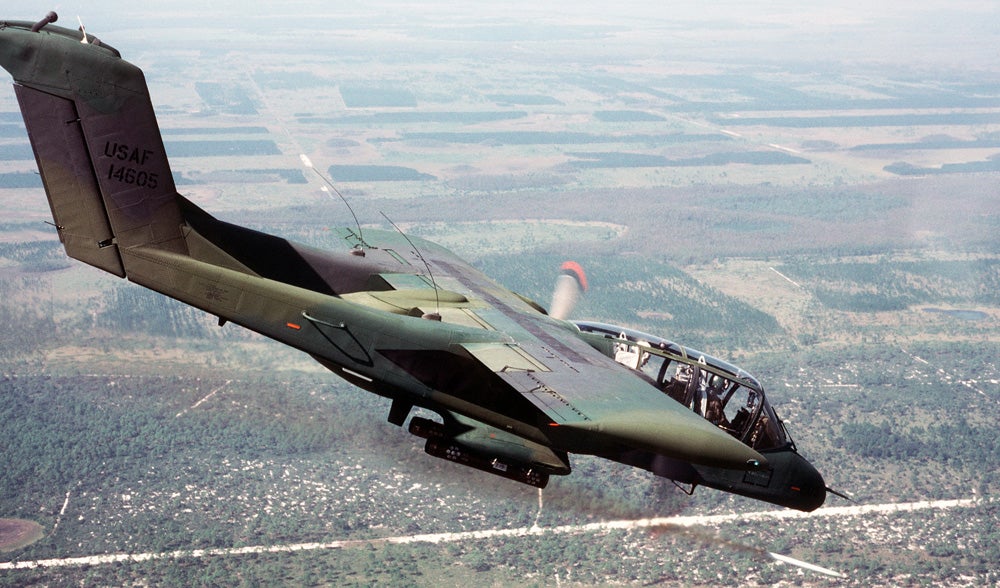
July 16, 1965 – The first flight of the North American Rockwell OV-10 Bronco, a lightweight, STOL aircraft developed for the US Army, Air Force and Marine Corps for observation, forward air control, helicopter escort, armed reconnaissance, gunfire spotting, utility and limited ground attack. Despite its diminutive size, the Bronco can carry up to 6,000 pounds of external stores, as well as paratroops or stretchers, and its turboprop engines allow for at least three hours of loiter time over the battlefield. The Bronco first saw service with the US Marine Corps in Vietnam, and has since served both the US Air Force and US Navy. In civilian use, the Bronco has served NASA and as a firefighting aircraft, and military versions have recently returned to the skies over Afghanistan and Syria in the fight against !!!error: Indecipherable SUB-paragraph formatting!!! . (US Air Force photo)
!!! UNKNOWN CONTENT TYPE !!!
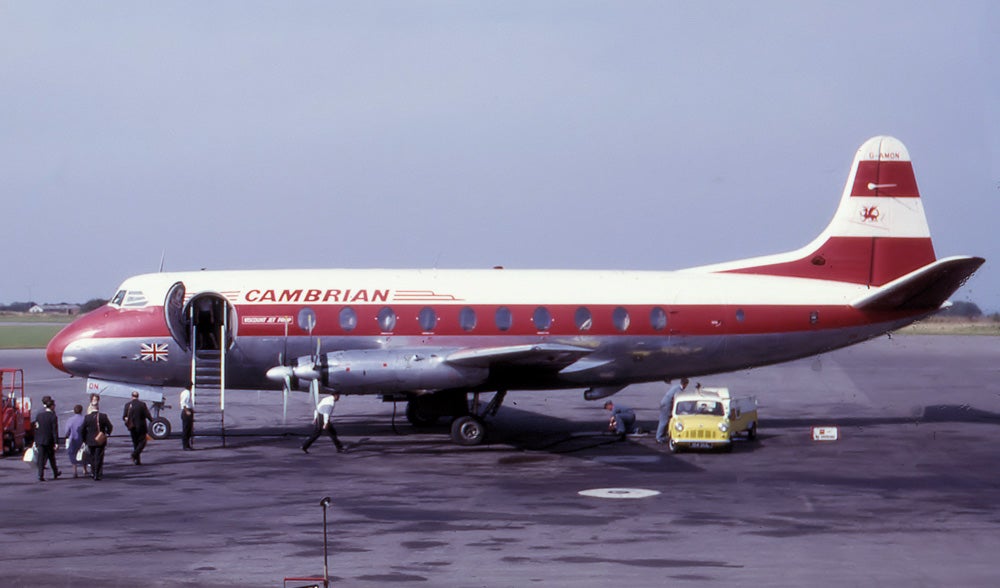
July 16, 1948 – The first flight of the Vickers Viscount, a medium range, pressurized airliner and the first airliner in the world to employ turboprop engines, becoming one of the most popular and successful post-war transport and cargo aircraft. Development of the Viscount resulted from the work of the !!!error: Indecipherable SUB-paragraph formatting!!! , a group founded to promote civilian aviation in England following WWII. The Viscount entered service with !!!error: Indecipherable SUB-paragraph formatting!!! (BEA) in 1953, providing the world’s first turboprop-powered passenger service and proving so successful that 160 aircraft had been ordered by only the second year of operations. A total of 445 were produced from 1948-1963, and the type was finally retired in 2008. (Photo by Arpingstone via !!!error: Indecipherable SUB-paragraph formatting!!! )
!!! UNKNOWN CONTENT TYPE !!!
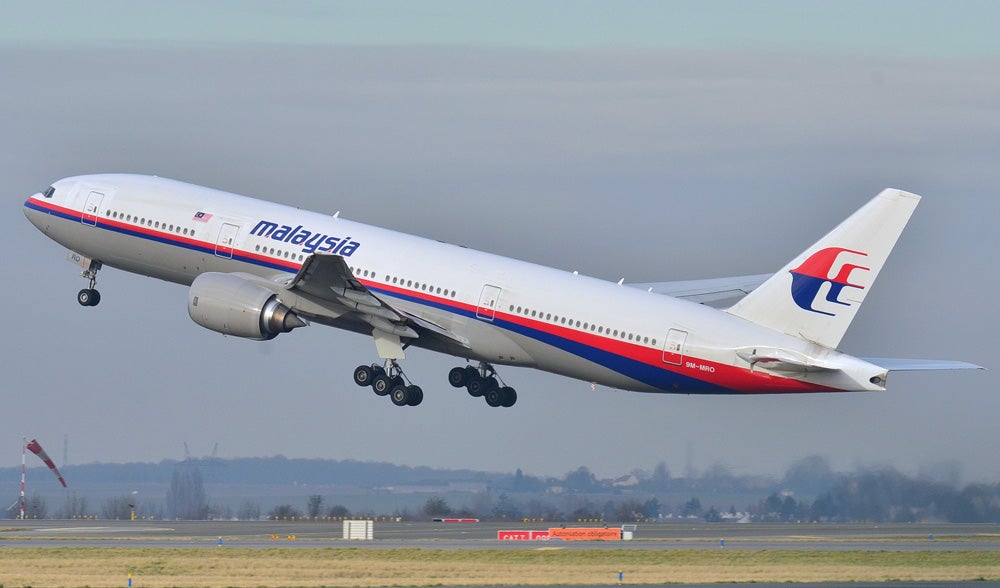
July 17, 2014 – Malaysia Airlines Flight 17 is shot down over eastern Ukraine. Following the unexplained disappearance of !!!error: Indecipherable SUB-paragraph formatting!!! over the southern Indian Ocean, Malaysian Airlines was again hit with tragedy when a second !!!error: Indecipherable SUB-paragraph formatting!!! (9M-MRO) was shot down by an antiaircraft missile over war-torn eastern Ukraine, killing all 298 passengers and crew. Much argument and acrimony remains over who is responsible. The Ukrainian government blames Russian-backed separatists, while the separatists blame the Ukranian government, and both sides in the ongoing conflict have the weapons necessary to bring down an aircraft cruising at 33,000 feet. Despite an investigation by the Dutch government, it may never be ascertained who fired the missile that destroyed the airliner. (Photo by Laurent Errera via !!!error: Indecipherable SUB-paragraph formatting!!! )
!!! UNKNOWN CONTENT TYPE !!!
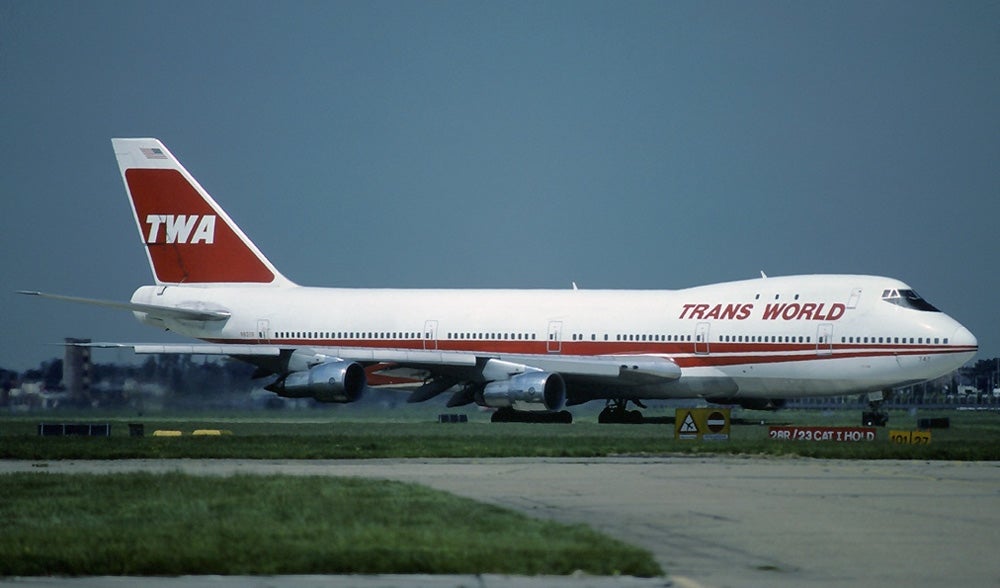
July 17, 1996 – A midair explosion destroys TWA Flight 800. TWA 800 was a regularly scheduled flight from New York to Leonardo to Rome when the !!!error: Indecipherable SUB-paragraph formatting!!! (N91339) exploded in midair shortly after takeoff, killing all 230 passengers and crew. No distress call was ever made prior to the explosion, and cockpit conversations appeared to be normal, except that just before the explosion the captain remarked about a “crazy fuel flow indicator.” In one of the most exhaustive investigations ever carried out, as much debris as could be found was brought to the surface and reconstructed in a hangar in Calverton, NY. After a four-year investigation, the final !!!error: Indecipherable SUB-paragraph formatting!!! pointed to the likely cause being a detonation of a fuel/air mixture in the center fuel tank that was ignited by an undetermined short circuit. Despite this explanation, conspiracy theories abound to this day. One of the most prevalent is that the airliner was shot down by a missile, either from the US Navy or terrorists in a boat or on shore. However, evidence for these theories remains circumstantial. (Photo by Eduard Marmet via !!!error: Indecipherable SUB-paragraph formatting!!! )
!!! UNKNOWN CONTENT TYPE !!!

July 17, 1939 – The first flight of the Bristol Beaufighter, a multi-role fighter bomber developed during WWII as a development of the !!!error: Indecipherable SUB-paragraph formatting!!! torpedo bomber. Originally conceived as a heavy fighter, the Beaufighter was subsequently developed into a night fighter and maritime strike and ground attack aircraft. Entering service at almost the same time as the first airborne radar sets, the Beaufighter’s large nose was big enough to accommodate the large radar sets of the time, and its heavy armament of four 20 mm cannons made it ideal to defend against German bombers. The Beaufighter also served RAF Coastal Command and in the Pacific, and flew as late as 1948 for the Israeli Air Force. Nearly 6,000 Beaufighters were produced from 1940-1946. (Canadian Forces photo)
!!! UNKNOWN CONTENT TYPE !!!
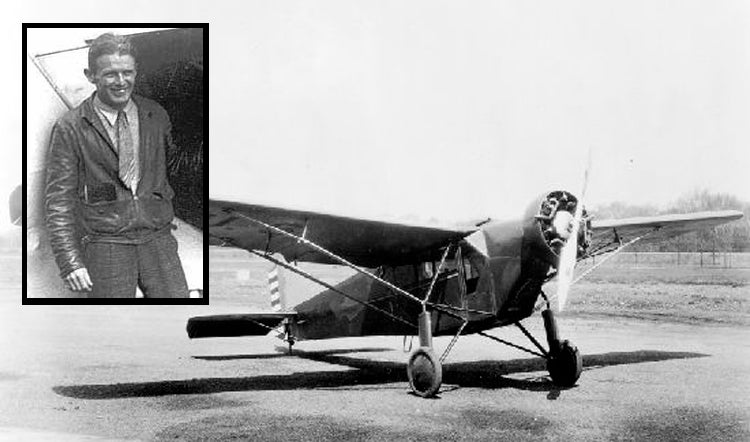
July 17, 1938 – Douglas “Wrong Way” Corrigan departs from Floyd Bennett Field and flies to Ireland. Corrigan worked as an aircraft constructor in San Diego before taking up flying and, inspired by !!!error: Indecipherable SUB-paragraph formatting!!! solo crossing of the Atlantic Ocean 1937, he decided to emulate the feat. Corrigan failed to gain permission for his flight, and after departing Floyd Bennett Field in New York for a planned return flight to California, Corrigan instead turned his !!!error: Indecipherable SUB-paragraph formatting!!! monoplane east and flew to Ireland anyway. He claimed that it was a navigational error that led to his wrong-way flight, but his plane was nevertheless modified to carry extra fuel for the journey. Corrigan never admitted that his mistake was intentional, and he and his plane returned to the US on the steamship !!!error: Indecipherable SUB-paragraph formatting!!! . (US Air Force photos)
!!! UNKNOWN CONTENT TYPE !!!
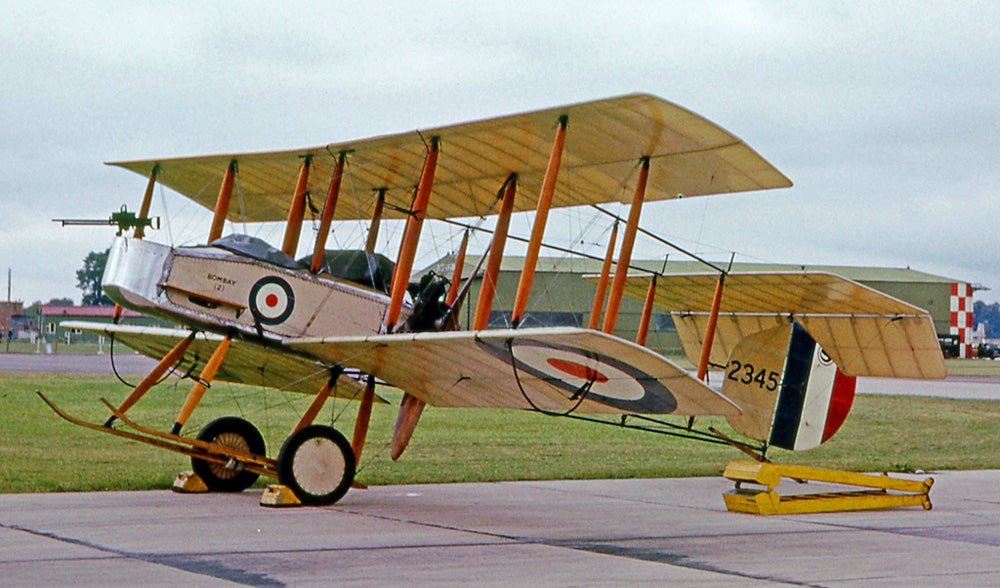
July 17, 1914 – The first flight of the Vickers F.B.5, a two-seat pusher biplane and the first purpose-built fighter plane ever produced. Known familiarly as the Gunbus, the F.B.5 was powered by a single !!!error: Indecipherable SUB-paragraph formatting!!! 9-cylinder engine which gave it a top speed of 70 mph, and was armed with a single 7.7mm !!!error: Indecipherable SUB-paragraph formatting!!! in the forward observer’s cockpit. The F.B.5 entered service in November 1914 and claimed its first victory over a German !!!error: Indecipherable SUB-paragraph formatting!!! monoplane, and by 1915, the F.B.5 had equipped the world’s first dedicated fighter squadron. By the end of the year it was outclassed by newer German designs, and was retired to serve as a trainer. A total of 224 were built. (Replica F.B.5 photo by RuthAS via !!!error: Indecipherable SUB-paragraph formatting!!! )
!!! UNKNOWN CONTENT TYPE !!!
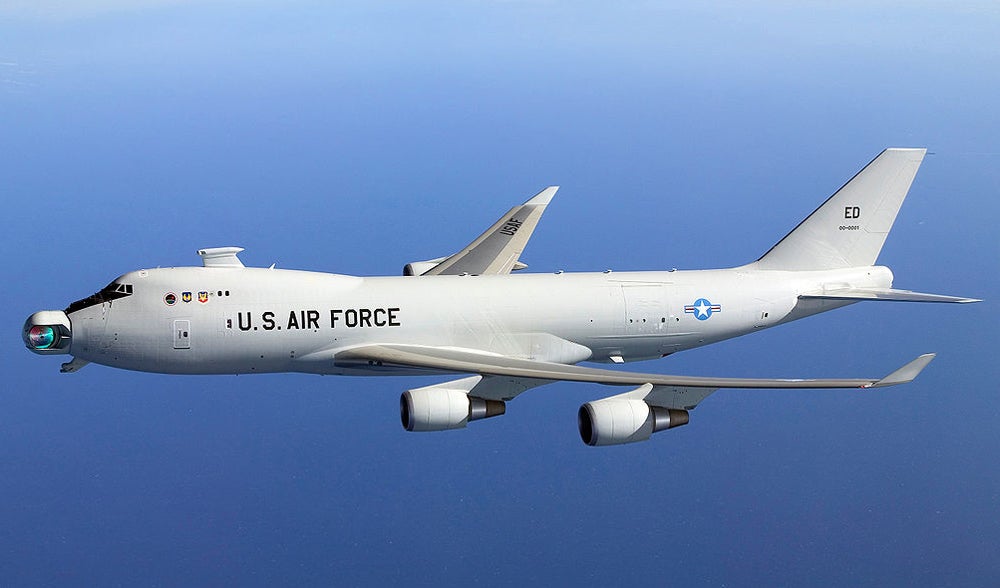
July 18, 2002 – The first flight of the Boeing YAL-1, a modified !!!error: Indecipherable SUB-paragraph formatting!!! that was armed with a megawatt-class !!!error: Indecipherable SUB-paragraph formatting!!! (COIL) to provide defense against tactical ballistic missiles. The program to fit a flying laser was initiated in 1996, with the laser provided by !!!error: Indecipherable SUB-paragraph formatting!!! housed in a turret built by !!!error: Indecipherable SUB-paragraph formatting!!! . In 2007, the system was test-fired at an airborne target for the first time, with a second successful test in 2010, then a third which destroyed two test missiles. The program was canceled in 2011, and the YAL-1 was flown to !!!error: Indecipherable SUB-paragraph formatting!!! in Arizona where it was put in storage before being scrapped in 2014. (Air Force photo)
!!! UNKNOWN CONTENT TYPE !!!
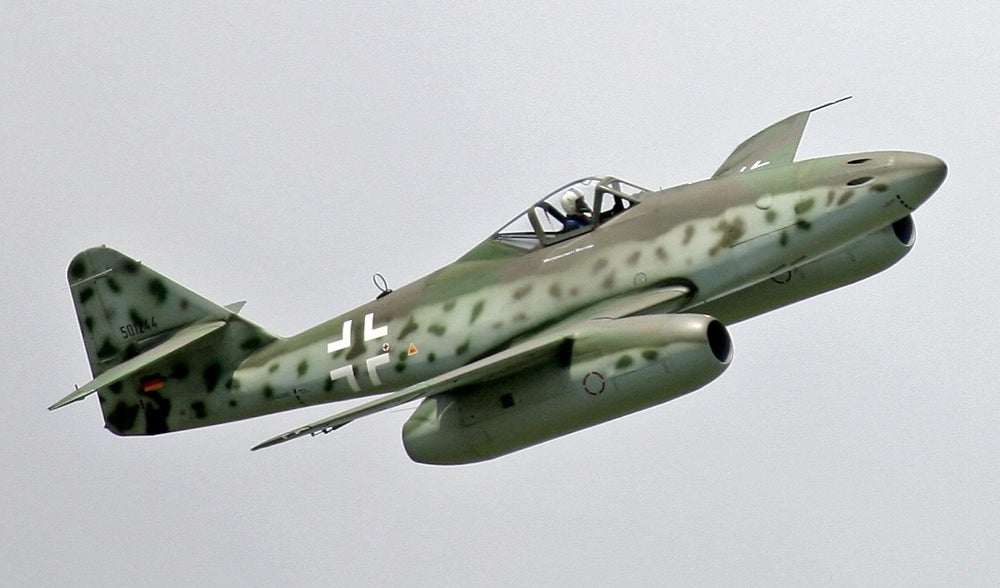
July 18, 1942 – The first jet-powered flight of the Messerschmitt Me 262.
Though the first flight of the Me 262, nicknamed
Schwalbe
(Swallow), had taken place more than a year earlier, delays in development of the
!!!error: Indecipherable SUB-paragraph formatting!!!
axial-flow turbojets meant that the 262's first flight was made a single
!!!error: Indecipherable SUB-paragraph formatting!!!
piston engines mounted in the nose. Development continued following the first jet-powered flight, and the Me 262 entered service in July 1942, eventually claiming 542 victories over Allied aircraft. However, difficulties with reliability of the early jet engines, and Allied attacks on Me 262 fuel supplies, hampered the operational capability of the jet fighter, and its impact on the war was ultimately negligible.
(Photo of replica Me 262 by Noop1958 via
!!!error: Indecipherable SUB-paragraph formatting!!!
)
!!! UNKNOWN CONTENT TYPE !!!

July 19, 1943 – The first flight of the Curtiss-Wright XP-55 Ascender. Fearing that American aircraft development was stagnating, the US Army Air Corps hoped to encourage innovative aircraft designs by issuing Request for Data R-40C in 1940. In response, the !!!error: Indecipherable SUB-paragraph formatting!!! proposed the XP-55 Ascender, a monoplane with a pusher propeller and a forward canard. Three prototypes were built, but testing showed that the airplane displayed poor stall characteristics, and the first prototype was lost to a crash. The third prototype (known derogatorily as the “ass ender”) saw further improvements to the wing, but this prototype was also lost to a crash that killed the pilot as well as two (or four) civilians on the ground. Ultimately, the Ascender’s performance was found to be inferior to conventional fighters, and advances in jet fighters led to the XP-55’s cancellation. (US Air Force photo)
!!! UNKNOWN CONTENT TYPE !!!
Recent Aviation History Posts
!!! UNKNOWN CONTENT TYPE !!!
!!! UNKNOWN CONTENT TYPE !!!
!!! UNKNOWN CONTENT TYPE !!!
!!! UNKNOWN CONTENT TYPE !!!
If you enjoy these Aviation History posts, please let me know in the comments. And if you missed any of the past articles, you can find them all at !!!error: Indecipherable SUB-paragraph formatting!!! .
!!! UNKNOWN CONTENT TYPE !!!
 MonkeePuzzle
> ttyymmnn
MonkeePuzzle
> ttyymmnn
07/19/2016 at 12:41 |
|
Messerschmitt Me 262, the first plastic model plane I ever built
 MonkeePuzzle
> ttyymmnn
MonkeePuzzle
> ttyymmnn
07/19/2016 at 12:45 |
|
excellent read as always.
the Apollo 11 segment makes me want to re-watch HBO’s From the Earth To The Moon, I think I shall do jsut that this evening.
 ttyymmnn
> MonkeePuzzle
ttyymmnn
> MonkeePuzzle
07/19/2016 at 12:47 |
|
Thanks. I think I’m starting to get the hang of this.
 Clemsie McKenzie
> ttyymmnn
Clemsie McKenzie
> ttyymmnn
07/19/2016 at 12:48 |
|
Damn that Ascender thing looks cool. Weird, but cool.
Great work!
 ttyymmnn
> MonkeePuzzle
ttyymmnn
> MonkeePuzzle
07/19/2016 at 12:49 |
|
I think mine was an F-5. Of course, I got glue on the canopy.

 Spaceball-Two
> ttyymmnn
Spaceball-Two
> ttyymmnn
07/19/2016 at 12:55 |
|
I could be wrong here but I don’t think there are any Beaufighters in flying condition these days. I saw pieces of one in a museum in Vancouver once. Kind of like the P-61. Not many were saved.
 MonkeePuzzle
> ttyymmnn
MonkeePuzzle
> ttyymmnn
07/19/2016 at 12:57 |
|
glue on the canopy, EVERY TIME!!!
 MonkeePuzzle
> ttyymmnn
MonkeePuzzle
> ttyymmnn
07/19/2016 at 12:57 |
|
starting? I think you’ve got it. It possibly the most consistent, well researched, edifying, and well written content Oppo has to offer.
 ttyymmnn
> Clemsie McKenzie
ttyymmnn
> Clemsie McKenzie
07/19/2016 at 12:57 |
|
Thanks. There were three aircraft that came out of the R-40C request, and they were all turkeys. In addition to the Ascender, there was the
Vultee XP-54
, nicknamed the
Swoose Goose
, and the
Northrop XP-56 Black Bullet
. The Swoose Goose had a cannon in the nose, and since the muzzle velocity was low the nose actually swiveled upward to lob the shells at the target. I
wrote about it
some time ago. I never got to the Ascender or the Black Bullet.

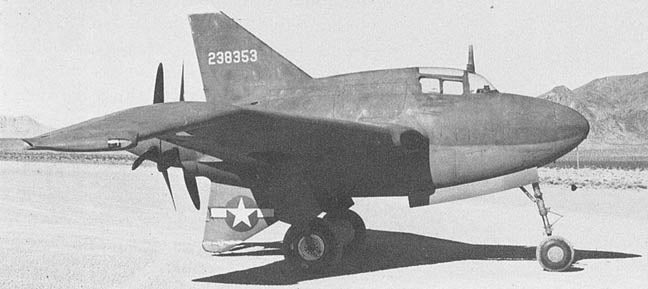
 ttyymmnn
> MonkeePuzzle
ttyymmnn
> MonkeePuzzle
07/19/2016 at 12:58 |
|
Thanks. I appreciate that.
 ttyymmnn
> Spaceball-Two
ttyymmnn
> Spaceball-Two
07/19/2016 at 12:59 |
|
According to Wiki, there are a handful in museums, and two undergoing restoration. One will hopefully be returned to the air.
 Jcarr
> ttyymmnn
Jcarr
> ttyymmnn
07/19/2016 at 13:00 |
|
United 232 still gets fairly regular coverage here in IA. The tales of children who were killed because the procedure was to place them on the floor is absolutely heartbreaking.
 ttyymmnn
> Jcarr
ttyymmnn
> Jcarr
07/19/2016 at 13:02 |
|
It is sad, no doubt. When we flew with our kids, we always paid for their own seat and strapped them in a car seat. It was a pain hauling two big Britax car seats through the airport, but the added benefit was having the kids immobile during the flight in a comfortable seat they were used to sitting in.
 Clemsie McKenzie
> ttyymmnn
Clemsie McKenzie
> ttyymmnn
07/19/2016 at 13:09 |
|
I just love the retro-futuristic look on these.
 ttyymmnn
> Clemsie McKenzie
ttyymmnn
> Clemsie McKenzie
07/19/2016 at 13:10 |
|
The Swoose Goose almost looks like a Y Wing.
 Clemsie McKenzie
> ttyymmnn
Clemsie McKenzie
> ttyymmnn
07/19/2016 at 13:17 |
|
Yeah! They look like something out of a period comic book! Reminds me of things you could see in the Blake and Mortimer comics, in a way:
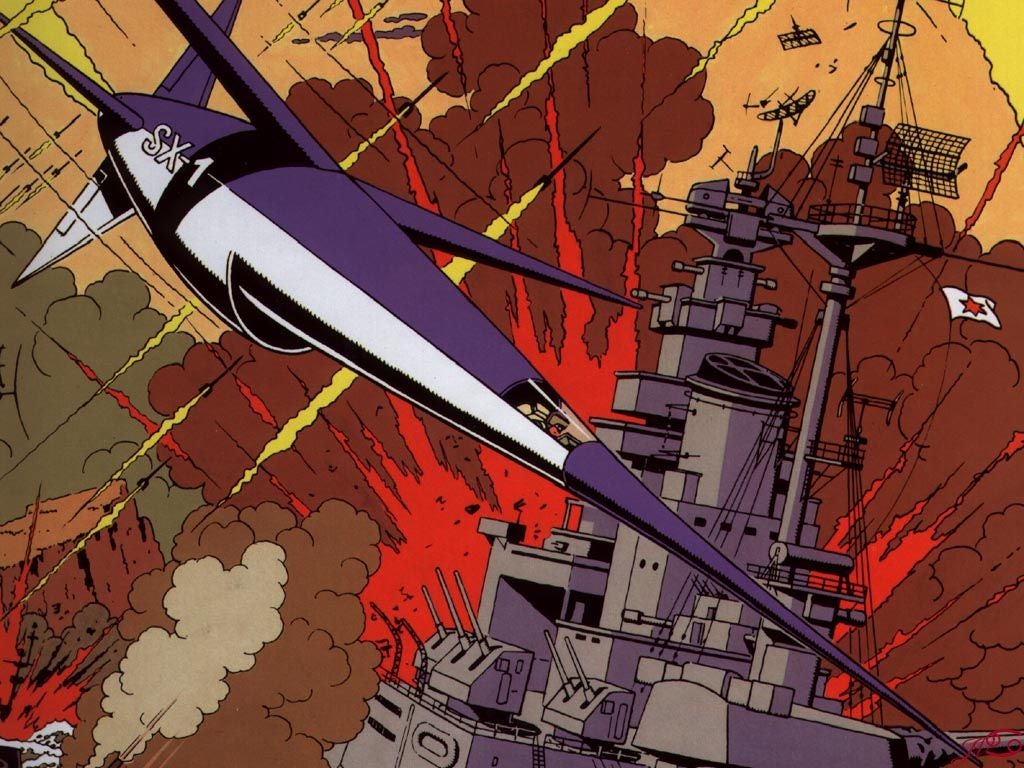
 ttyymmnn
> Clemsie McKenzie
ttyymmnn
> Clemsie McKenzie
07/19/2016 at 13:36 |
|
Sometimes, truth is as strange as fiction. Behold, the Douglas X-3 Stiletto .

 Clemsie McKenzie
> ttyymmnn
Clemsie McKenzie
> ttyymmnn
07/19/2016 at 13:39 |
|
That is stunning! And remarkably similar. Although mine can go underwater, ha!
 You can tell a Finn but you can't tell him much
> ttyymmnn
You can tell a Finn but you can't tell him much
> ttyymmnn
07/19/2016 at 13:58 |
|
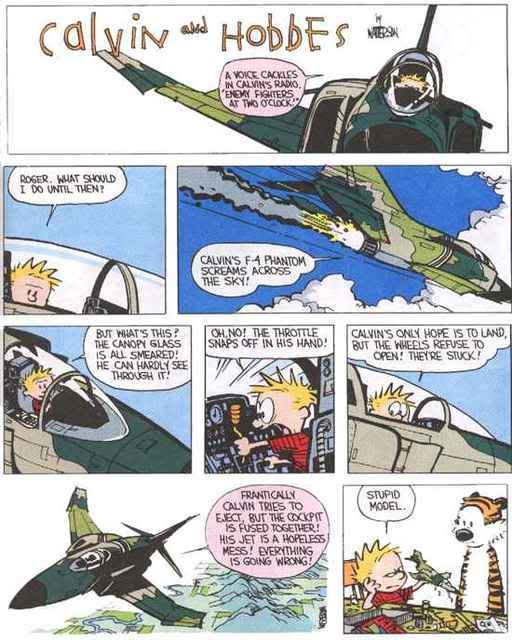
Calvin & Hobbes perfectly captures every model I attempted to build as a kid.
 You can tell a Finn but you can't tell him much
> ttyymmnn
You can tell a Finn but you can't tell him much
> ttyymmnn
07/19/2016 at 14:02 |
|
Whispering Death.
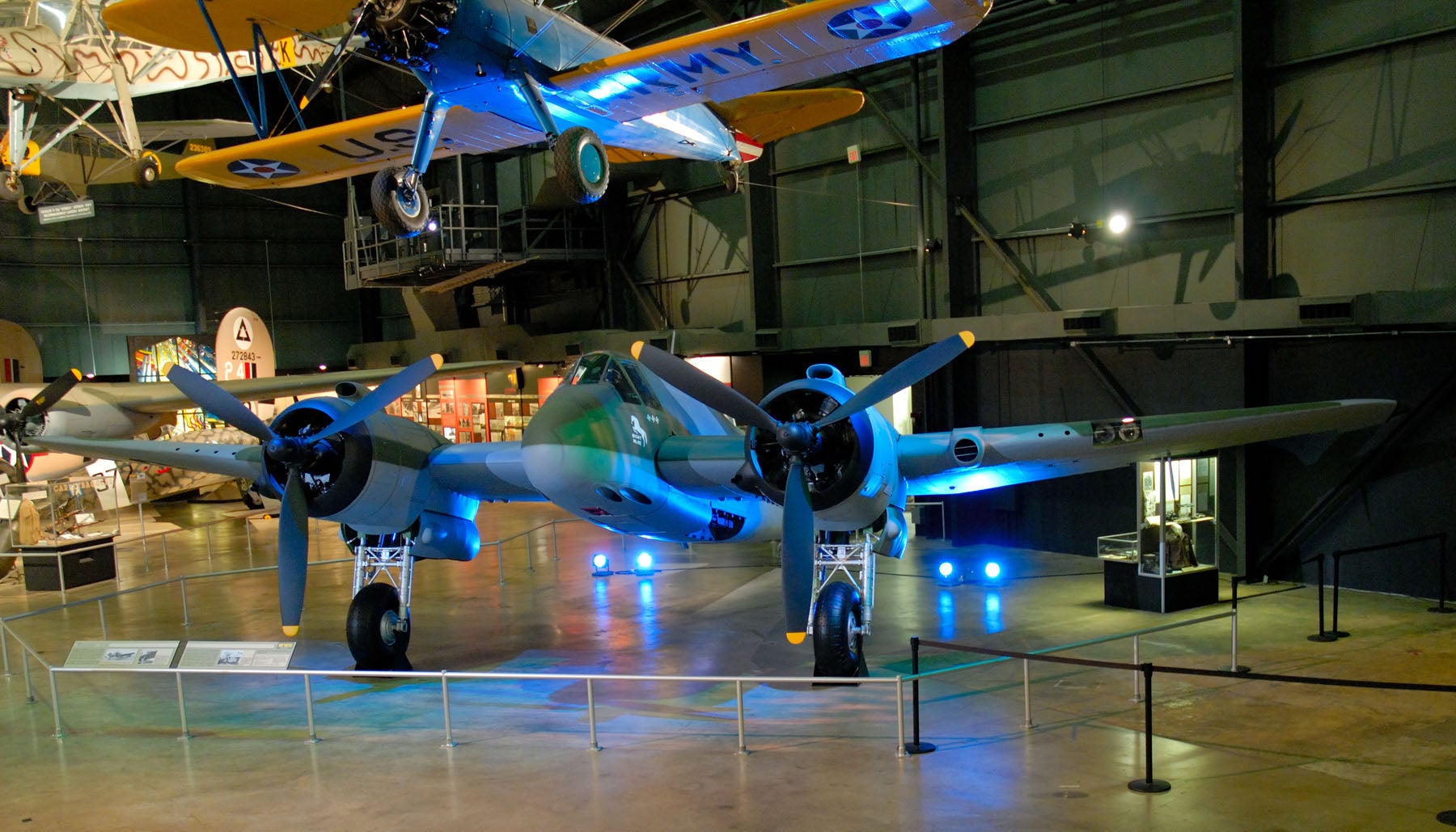
Similar to the apocryphal stories of the P-38 Lighting being called “der Gabelschwanz Teufel”, the Beaufighter may or may not have been called “Whispering Death” by the Japanese.
 ttyymmnn
> You can tell a Finn but you can't tell him much
ttyymmnn
> You can tell a Finn but you can't tell him much
07/19/2016 at 14:13 |
|
I knew there was a strip Thad specifically addressed glue on the windscreen. Thanks.
 You can tell a Finn but you can't tell him much
> ttyymmnn
You can tell a Finn but you can't tell him much
> ttyymmnn
07/19/2016 at 14:18 |
|
Every single strip about building models accurately captures my experiences with building them as a kid.

I was always crushed when the finished product looked like it was put together by an eight year old when the box clearly showed it being perfectly detailed right down to the stitching on the pilots clothes.
 RallyWrench
> ttyymmnn
RallyWrench
> ttyymmnn
07/19/2016 at 14:20 |
|
Wow, all kinds of significant things this week. Thanks for the coverage.
 ttyymmnn
> RallyWrench
ttyymmnn
> RallyWrench
07/19/2016 at 14:30 |
|
You’re welcome!
 facw
> ttyymmnn
facw
> ttyymmnn
07/19/2016 at 14:33 |
|
The XP-55 is getting closer to some cool looking fictional stuff, specifically the Hughes Bloodhawk:
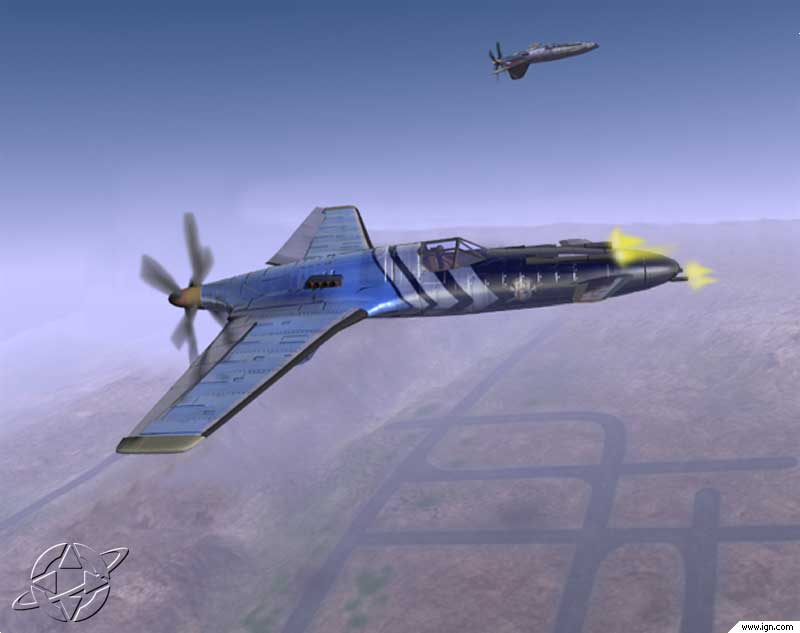
Fun stuff aside, the ascender’s swept wing would have very unusual design element for the time.
 ttyymmnn
> You can tell a Finn but you can't tell him much
ttyymmnn
> You can tell a Finn but you can't tell him much
07/19/2016 at 14:34 |
|
My favorite part was always the decals, and I could never put those damned things on without getting a wrinkle in it. Do they still make the ones you have to soak off the paper? The last model I tried to build was a B-26 that I worked on about 25 years ago, right after I got married. I discovered that, no matter how hard I tried, I simply didn’t have the tools to do it right. My attempts to use putty were a disaster, and I tried my best to get airbrushed results with a rattle can of Testors. I did a really nice job on the pilot, but ruined the whole thing when I tried to brush on the D-Day invasion stripes. I’ve still got it in the box, but the wing spars broke off the fuselage during a move. I would love to try again, but you really need a dedicated spot to put everything out and leave it out, and I just don’t have the room.
 ttyymmnn
> facw
ttyymmnn
> facw
07/19/2016 at 14:36 |
|
I’m pretty sure that illustration used the Ascender as a starting off point. Back in the days of Star Wars and Star Blazers, my friend and I would use fighter aircraft as the basis for designing space fighters and bombers. Good times.
 You can tell a Finn but you can't tell him much
> ttyymmnn
You can tell a Finn but you can't tell him much
> ttyymmnn
07/19/2016 at 15:44 |
|
I don’t think I’ve looked at a model since I was 12. My memories mainly consist of random parts breaking, things getting glued to the newspaper that my mother wisely made me put on the kitchen table, paint getting everywhere except where it was supposed to go and those stupid, stupid decals tearing in half before I managed to finish peeling them off the backing. The ones that you had to soak off the paper were absolutely hateful and greatly expanded my vocabulary.